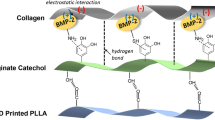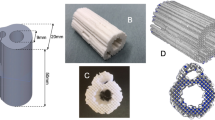Abstract
Background
Synthetic biopolymers have been widely used to manage bone effects in recent years. The study aims to analyse the ability to repair artificially created ulnar bone defects with the scaffold made of Polycaprolactone (PCL) and investigate the material's feasibility as a bone graft substitute.
Method
We have tested a novel 3D biodegradable Polycaprolactone Poly-l-Lactide polymer scaffold in an experimental animal model. 14 adults New Zealand white rabbits were used to create the ulnar defect model of 10 mm in length, and randomly divided into group A (test-12 rabbits), group B (control-3 rabbits). The defect area was implanted with the PCL scaffold in the test group, whereas it was left as such in the control group. The repairing effect was observed by gross, histology, radiology, and the Scanning electron microscopy (SEM) at 4, 8, and 12 weeks. Cook's scoring was used to assess the radiological parameters.
Results
Histological and radiological results showed better quality of bone regeneration in the defect area at 12 week follow-up period. The SEM image at that period showed impregnation of the osteogenic cells in the surface and pores of the scaffold material. It was evident that the scaffold was thoroughly degraded, corresponding with osteogenesis. New bone formation was statistically significant in the test group than in the control group.
Conclusion
The Polycaprolactone Poly-l-Lactide polymer scaffold is biodegradable in-vivo at a suitable half-life. It has an excellent porous structure, no tissue toxicity, excellent mechanical strength, high osteogenesis potential, and osteoconductivity. Therefore, it can be used as bone graft material in the gap non-union and as a void filler in bone defects.






Similar content being viewed by others
References
Oryan, A., Monazzah, S., & Bigham-Sadegh, A. (2015). Bone injury and fracture healing biology. Biomedical and Environmental Sciences., 28(1), 57–71.
Baldwin, P., Li, D. J., Auston, D. A., Mir, H. S., Yoon, R. S., & Koval, K. J. (2019). Autograft, allograft, and bone graft substitutes: clinical evidence and indications for use in the setting of orthopaedic trauma surgery. Journal of Orthopaedic Trauma, 33(4), 203–213.
Emara, K. M., Diab, R. A., & Emara, A. K. (2015). Recent biological trends in management of fracture non-union. World Journal of Orthopedics., 6(8), 623–628.
Roberts, T. T., & Rosenbaum, A. J. (2012). Bone grafts, bone substitutes and ortho-biology. The bridge between basic science and clinical advancements in fracture healing. Organogenesis, 8(4), 114–124.
Ruby, D., Sumit, K., Rahul, P., Aman, M., Deepti, N., Dhirendra, S. K., & Divya, M. (2020). Polycaprolactone as biomaterial for bone scaffolds: Review of literature. Journal of Oral Biology and Craniofacial Research., 10(1), 381–388.
Fu, X., Sammons, R. L., Bertoti, I., Jenkins, M. J., & Dong, H. (2012). Active screen plasma surface modification of polycaprolactone to improve cell attachment. Journal of Biomedical Materials Research, Part B: Applied Biomaterials, 100B, 314–320.
Pearce, A. I., Richards, R. G., Milz, S., Schneider, E., & Pearce, S. G. (2007). Animal models for implant biomaterial research in bone: A review. European Cells and Materials, 13, 1–10.
Singh, V., Singh, M., Belbase, R. J., & Rastogi, A. (2021). Healing of artificially created gap non-union using autologous cultured osteoblasts impregnated over three-dimensional biodegradable scaffold: An experimental study (Rabbit). Indian Journal of Orthopaedics., 55(Suppl 2), 460–465. https://doi.org/10.1007/s43465-020-00288-z.PMID:34306561;PMCID:PMC8275701
Veeresh, V., Sinha, S., Manjhi, B., Singh, B. N., Rastogi, A., & Srivastava, P. (2021). How is biodegradable scaffold effective in gap non-union? insights from an experiment. Indian Journal of Orthopaedics., 55(3), 741–748. https://doi.org/10.1007/s43465-020-00313-1.PMID:33995882;PMCID:PMC8081820
Cook SD, Barrack RL, Santman M, et al. The Otto Aufranc Award. Strut allograft healing to the femur with recombinant human osteogenic protein-1. Clinical Orthopaedics and Related Research. 2000 (381):47–57.
Khan, S. N., Cammisa, F. P., Jr., Sandhu, H. S., Diwan, A. D., Girardi, F. P., & Lane, J. M. (2005). The biology of bone grafting. Journal of American Academy of Orthopaedic Surgeons, 13, 77–86.
Flynn JM. Fracture Repair and Bone Grafting. OKU 10: Orthopaedic Knowledge Update Rosemont, IL: American Academy of Orthopaedic Surgeons, 2011. 11–21.
Kwong, F. N. K., & Harris, M. B. (2008). Recent developments in the biology of fracture repair. Journal of American Academy of Orthopaedic Surgeons, 16, 619–625.
Jones, J. R. (2013). Review of bioactive glass: From Hench to hybrids. Acta Biomaterialia, 9(1), 4457–4486.
Hench, L. L. (2006). The story of bioglass. Journal of Materials Science. Materials in Medicine, 17(11), 967–978.
Chaudhari, A., Braem, A., Vleugels, J., et al. (2011). Bone tissue response to porous and functionalized titanium and silica based coatings. PLoS ONE, 6(9), e24186.
Ulery, B. D., Nair, L. S., & Laurencin, C. T. (2011). Biomedical applications of biodegradable polymers. Journal of Polymer Science Part B Polymer Physics, 49(12), 832–864.
Middleton, J. C., & Tipton, A. J. (2000). Synthetic biodegradable polymers as orthopedic devices. Biomaterials, 21(23), 2335–2346.
Lee, J. Y., Son, S., Son, J., Kang, S., & Choi, S.-H. (2016). Bone-healing capacity of PCL/PLGA/duck beak scaffold in critical bone defects in a rabbit model. BioMed Research International., 2016, 1–10. https://doi.org/10.1155/2016/2136215
Zheng, P., Yao, Q., Mao, F., Liu, N., Yan, Xu., Wei, Bo., & Wang, L. (2017). Adhesion, proliferation and osteogenic differentiation of mesenchymal stem cells in 3D printed poly-ε-caprolactone/hydroxyapatite scaffolds combined with bone marrow clots. Molecular Medicine Reports, 16(4), 5078–5084.
Bignon, A., Chouteau, J., Chevalier, J., Fantozzi, G., Carret, J. P., Chavassieux, P., Boivin, G., Melin, M., & Hartmann, D. (2003). Effect of micro- and macroporosity of bone substitutes on their mechanical properties and cellular response. Journal of Materials Science. Materials in Medicine, 14, 1089–1097.
Engelberg, I., & Kohn, J. (1991). Physico-mechanical properties of degradable polymers used in medical applications: Comparative study. Biomaterials, 12(3), 292–304.
Author information
Authors and Affiliations
Corresponding author
Ethics declarations
Conflict of interest
Author declares no potential conflict of interest.
Ethical standard statement
This article does not contain any studies with human or animal subjects performed by the any of the authors.
Informed consent
For this type of study informed consent is not required.
Additional information
Publisher's Note
Springer Nature remains neutral with regard to jurisdictional claims in published maps and institutional affiliations.
Rights and permissions
About this article
Cite this article
Rajendran, S., Nallakumarasamy, A., Saraf, S.K. et al. Outcome Analysis of Osseous Ingrowth in an Artificially Created Gap Non-union Using the Novel 3D Biodegradable Polycaprolactone Poly-l-Lactide Polymer Scaffold: Insights from an Experimental Study. JOIO 56, 1410–1416 (2022). https://doi.org/10.1007/s43465-022-00657-w
Received:
Accepted:
Published:
Issue Date:
DOI: https://doi.org/10.1007/s43465-022-00657-w




